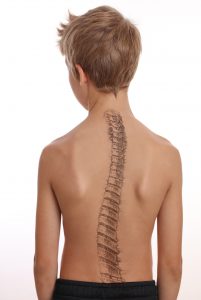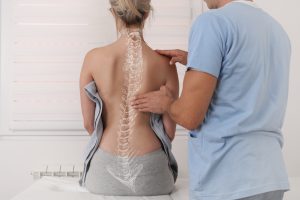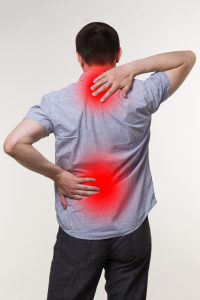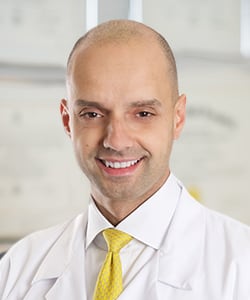Scoliosis Treatment in Westchester County, NY

What is scoliosis?
A healthy spine has a very slight curve, which is natural and normal. However, for some people, the curve is more dramatic, taking on an S or C shape, and sometimes causing poor posture or discomfort. Scoliosis usually onsets early in life so it is more commonly diagnosed in children. Adults may develop scoliosis too, though. An orthopedic care facility, such as Specialty Orthopaedics in New York, can assess your spine and provide you with the most innovative approaches to correcting spinal deformities.
What are the different types of scoliosis?
Scoliosis can be classified by its cause. There are three different types: idiopathic, congenital, or neuromuscular.
Idiopathic scoliosis
Idiopathic scoliosis is by far the most common type of scoliosis. Its title, idiopathic, which means the exact cause is not known, is somewhat disconcerting but there it is. Adolescent idiopathic scoliosis is the most common type of scoliosis and is usually diagnosed during puberty. This is the diagnosis when all other causes are excluded.
Congenital scoliosis
Congenital scoliosis results from an embryological malformation of one or more vertebrae and may occur in any location of the spine. The vertebral abnormalities cause curvature and other deformities of the spine because one area of the spinal column lengthens at a slower rate than the rest. The geometry and location of the abnormalities determine the rate at which scoliosis progresses as the child grows.
Neuromuscular scoliosis
Neuromuscular scoliosis involves scoliosis that is associated with other neurological or muscular diseases, such as cerebral palsy, muscular dystrophy, spina bifida, and others. This type of scoliosis progresses more rapidly than idiopathic scoliosis and often requires surgery to correct it.
What are the symptoms of scoliosis?
See a specialist in scoliosis and spinal deformities if you believe you may be suffering from a back problem. In most cases, scoliosis will not cause any pain. However, if scoliosis is severe, it may put pressure on the surrounding nerves, tissues, and discs. In these cases, you could have serious spinal pain or a condition known as sciatica.
 The following symptoms are common among people who suffer from scoliosis spinal deformity:
The following symptoms are common among people who suffer from scoliosis spinal deformity:
- Lopsided hips
- Uneven shoulders
- Inability to stand straight
- Crooked alignment of ribs
- Flat waist on only one side of the body
Is scoliosis hereditary?
There is a direct genetic correlation to the development of scoliosis. Approximately 30 percent of patients with pediatric and adolescent idiopathic scoliosis have a family history of the condition.
How is scoliosis diagnosed?
One of our experienced orthopedic physicians can help you determine whether you’re suffering from scoliosis or another spinal condition. We’re experts when it comes to diagnosing scoliosis and other orthopedic problems. During an office visit, we’ll conduct a physical exam, which will usually involve looking at your spine for any irregularities. We’ll also ask you about any relevant medical conditions and your current symptoms. Often, we’ll have you undergo x-ray testing to measure the extent of the curvature in your spine and to detect whether any of your spinal bones are out of place.
How is scoliosis treated?
 We always approach scoliosis treatment with the least invasive options first. If your scoliosis is mild, you can likely recover using one of these conservative options:
We always approach scoliosis treatment with the least invasive options first. If your scoliosis is mild, you can likely recover using one of these conservative options:
- Physical therapy
- Spinal brace/scoliosis brace
In the event that your scoliosis is causing you pain or is progressing, we will likely recommend scoliosis surgery. If you’re suffering from an underlying spinal condition that is causing scoliosis, we might recommend a different spinal surgery.
Is wearing a back brace effective in treating scoliosis?
When a child’s bones are still growing and he or she has moderate scoliosis, we may recommend a brace. Braces won’t cure scoliosis or reverse the curve, but they can prevent further progression.
These braces are typically made of plastic and contoured to conform to the child’s body. That makes the brace almost invisible under clothing. These aren’t the old braces you may have seen from decades ago that fit around the neck.
These braces are only as effective as the hours worn every day. If these braces are worn between 16 and 23 hours every day, they will stop curve progression in about 80 percent of children. They should be worn day and night, and they don’t usually preclude the child from participating in most activities. If necessary, the brace can be removed to participate in sports and similar activities.
Once the child’s bones have stopped growing, the child no longer wears the brace.
Are there other health issues associated with scoliosis?
Most patients with scoliosis are not bothered by it other than their abnormal posture and the cosmetic concerns associated with it. Only when scoliosis is severe and left untreated can it cause additional health problems. These include:
- Back pain in adulthood as ligaments weaken
- Tingling or numbness in the legs
- Permanent deformities
- Chronic fatigue
- Breathing problems — The rib cage may press against the lungs
- Heart problems — The rib cage may press against the heart, making it more difficult for it to pump efficiently
- A spine that curves inward or downward too much, otherwise known as swayback
- A pelvis that thrusts forward on one side
- One leg that appears shorter than the other
Is physical therapy used to help treat scoliosis? How long does it last?
A specific form of physical therapy known as the Schroth Method is a non-surgical option for treating scoliosis. This method is based on exercises that are tailored to each patient’s spine curvature. These customized exercises work to return the curved spine to a more natural position. This form of physical therapy focuses on three areas:
- Restoring muscular symmetry and alignment of posture
- Breathing into the concave side of the body
- Teaching the patient to be aware of their posture
The Schroth Method or any other type of physical therapy does not reverse scoliosis; the goal is to prevent scoliosis from advancing.
The length of the physical therapy program varies, running anywhere from five to 20 sessions. Sessions last from 45 minutes to an hour. Once the sessions are completed, the patient has the knowledge to continue the exercises on his or her own.
Can you prevent scoliosis?
Despite admonitions from moms everywhere to “Stand up straight” or “Stop slouching,” practicing good posture does not prevent scoliosis from developing. Doctors aren’t exactly sure what causes the most common form of scoliosis, adolescent idiopathic scoliosis. But they know it is not preventable.
Many things get wrongly blamed for causing scoliosis. This is kind of how eating potato chips or chocolate gets blamed, wrongly, for causing teenage acne. People think things such as childhood sports injuries, carrying overly heavy backpacks, poor posture, and being overweight cause scoliosis. Not true.
Even if you’re a yoga aficionado or do a thousand crunches a day to strengthen your back, these activities won’t prevent scoliosis. Yes, they can help to relieve some symptoms and are good for general health, but they won’t prevent the spine curvature of scoliosis.
The only form of scoliosis that you could say could be somewhat preventable would be adult scoliosis due to osteoporosis. This disease that causes our bones, including our vertebrae, to become brittle and break down, can lead to abnormal curving of the spine. But this isn’t true scoliosis as compared to the three forms described above.
Scheduled Your Consultation Today
If you are experiencing symptoms of scoliosis, visit Specialty Orthopaedics. Our New York orthopedic practice is home to a team of fellowship-trained orthopedists in a variety of orthopedic specialty areas. We offer comprehensive treatment for musculoskeletal disorders in a caring and responsive clinical atmosphere. Give us a call at 914.686.0111 or fill out the form on this page to schedule your appointment today.








